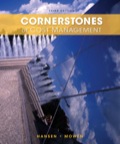
Concept explainers
Jolene Askew, manager of Feagan Company, has committed her company to a strategically sound cost reduction program. Emphasizing life-cycle cost management is a major part of this effort. Jolene is convinced that production costs can be reduced by paying more attention to the relationships between design and manufacturing. Design engineers need to know what causes
where
Upon seeing the cost formula, Jolene quickly calculated the projected gross profit to be $50,000. This produced a gross profit of $2 per unit, well below the targeted gross profit of $4 per unit. Jolene then sent a memo to the Engineering Department, instructing them to search for a new design that would lower the costs of production by at least $50,000 so that the target profit could be met.
Within two days, the Engineering Department proposed a new design that would reduce unit-variable cost from $10 per machine hour to $8 per machine hour (Design Z). The chief engineer, upon reviewing the design, questioned the validity of the controller’s cost formula. He suggested a more careful assessment of the proposed design’s effect on activities other than machining. Based on this suggestion, the following revised cost formula was developed. This cost formula reflected the cost relationships of the most recent design (Design Z).
where
Based on scheduling and inventory considerations, the product would be produced in batches of 1,000; thus, 25 batches would be needed over the product’s life cycle. Furthermore, based on past experience, the product would likely generate about 20 engineering change orders.
This new insight into the linkage of the product with its underlying activities led to a different design (Design W). This second design also lowered the unit-level cost by $2 per unit but decreased the number of design support requirements from 20 orders to 10 orders. Attention was also given to the setup activity, and the design engineer assigned to the product created a design that reduced setup time and lowered variable setup costs from $5,000 to $3,000 per setup. Furthermore, Design W also creates excess activity capacity for the setup activity, and resource spending for setup activity capacity can be decreased by $40,000, reducing the fixed cost component in the equation by this amount.
Design W was recommended and accepted. As prototypes of the design were tested, an additional benefit emerged. Based on test results, the post-purchase costs dropped from an estimated $0.70 per unit sold to $0.40 per unit sold. Using this information, the Marketing Department revised the projected market share upward from 50 percent to 60 percent (with no price decrease).
Required:
- 1. Calculate the expected gross profit per unit for Design Z using the controller’s original cost formula. According to this outcome, does Design Z reach the targeted unit profit? Repeat, using the engineer’s revised cost formula. Explain why Design Z failed to meet the targeted profit. What does this say about the use of unit-based costing for life-cycle cost management?
- 2. Calculate the expected profit per unit using Design W. Comment on the value of activity information for life-cycle cost management.
- 3. The benefit of the post-purchase cost reduction of Design W was discovered in testing. What direct benefit did it create for Feagan Company (in dollars)? Reducing post-purchase costs was not a specific design objective. Should it have been? Are there any other design objectives that should have been considered?
Want to see the full answer?
Check out a sample textbook solution
Chapter 11 Solutions
EBK CORNERSTONES OF COST MANAGEMENT
 Cornerstones of Cost Management (Cornerstones Ser...AccountingISBN:9781305970663Author:Don R. Hansen, Maryanne M. MowenPublisher:Cengage Learning
Cornerstones of Cost Management (Cornerstones Ser...AccountingISBN:9781305970663Author:Don R. Hansen, Maryanne M. MowenPublisher:Cengage Learning Essentials of Business Analytics (MindTap Course ...StatisticsISBN:9781305627734Author:Jeffrey D. Camm, James J. Cochran, Michael J. Fry, Jeffrey W. Ohlmann, David R. AndersonPublisher:Cengage Learning
Essentials of Business Analytics (MindTap Course ...StatisticsISBN:9781305627734Author:Jeffrey D. Camm, James J. Cochran, Michael J. Fry, Jeffrey W. Ohlmann, David R. AndersonPublisher:Cengage Learning

